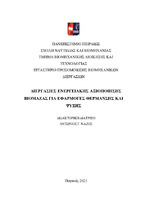Διεργασίες ενεργειακής αξιοποίησης βιομάζας για εφαρμογές θέρμανσης και ψύξης

View/
Keywords
Acid-catalyzed wet torrefaction ; Acid hydrolysis ; Barley straw ; Wheat straw ; Combined severity factor ; Enhancement factor ; Energy yield ; Higher heating value ; Response surface methodology ; Torrefaction ; Severity factor ; Sustainable developmentAbstract
Numerous recent studies have focused on thermally pretreated lignocellulosic biomass as a substitute of fossil fuels. These studies deal with the efficient use of the renewable energy sources, to ensure sustainable consumption and production patterns, by achieving Sustainable Development Goals no. 7 and no. 12 of the United Nations 2030 Agenda. The use of renewable energy sources and especially biomass is important due to economic factors, since the use of low-cost energy sources is more attractive, enhancing the preservation of a clean environment. Thermal applications are the most common and traditional uses of biomass worldwide. Several biomass-based heating and cooling systems have been developed, which are already commercially available and economically competitive. Biomass is used in various of ways for heating production. Heating applications cover the whole range, from small scale heating of a single room and a few kW boilers for domestic heating, to multi kW boilers for industry and district heating. Large-scale units can be combined with power cycles for combined heat and power (CHP) generation. Innovative technologies such as the Organic Rankine Cycle (ORC) and gasification also offer efficient cogeneration.
This thesis contributes to this research by investigating the enhancement of the barley and wheat straw Higher Heating Value (HHV), via wet and dry torrefaction pretreatment, to be used as solid fuel in heating and cooling systems. In particular, the effect of time, temperature and acid concentration on wet torrefaction process is investigated. In addition, innovative kinetic models were applied to fit the experimental data using a severity factor (R0) that combines the effect of reaction time, temperature and acid concentration in the case of a non-isothermal process. Especially, the possibility of improving the HHV of barley straw with (i) Dry Torrefaction, so called torrefaction, in a furnace, and (ii) Acid Catalyzed Wet Torrefaction (ACWT), so called acid hydrolysis or acid catalyzed hydrothermal treatment, in a Parr 4553 3.75 L batch reactor, was examined. Wheat straw was also studied as regards HHV enhancement. In all cases, a Parr 1341 Plain Jacket Bomb Calorimeter was used to measure the HHV of the samples. These samples were also studied using Ultimate and Proximate Analysis, and scanning electron microscope (SEM).
As regards the ACWT pretreatment, two different simulation approaches were applied: (a) Combined Severity Factor (CSF) and (b) Response Surface Methodology (RSM) based on the Box – Behnken design of experiments (DoE). Sulfuric acid (SA) concentration, temperature and time were the ACWT parameters examined herein. As regards the Dry Torrefaction pretreatment, various experimental conditions were studied using a Nuve Muffle Furnace, with numerous sets of temperature and residence time. In addition, innovative kinetic models were applied to adapt the experimental data using CSF, which combines the effect of temperature and time on the torrefaction process.
In conclusion, the barley and wheat straw HHV, pretreated via ACWT and dry torrefaction was significantly increased at optimal pretreatment conditions, resulting to the production of a biomass-based solid fuel, appropriate for heating and cooling systems feeding, within the zero-waste circular economy concept.

